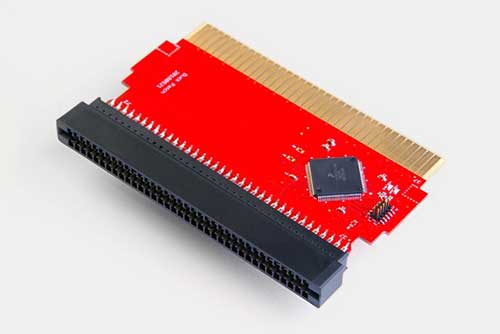It would never be released in its current form today—its somewhat realistic gun shape would never fly in 2018, in no small part because of the Lazer Tag saga that partly did in Nintendo’s one-time partner Worlds of Wonder—but it’s an amazing piece of nostalgia.
The nostalgia has its limits, though, and it’s largely due to the myriad technical issues that prevent the device from working on modern flat-screen TV sets. (Long story short: Old TVs are instant; new ones have a slight amount of lag.)
Sadly, though, an attempt to solve those problems seems to have been left by the wayside by the gamers who seemingly should love it the most.
Modern Mallard
Metsasta LLC is raising funds for Modern Mallard on Kickstarter! A simple kit for the NES video game Duck Hunt that makes it compatible with modern TVs
Recently, I stumbled upon a Kickstarter for a project called Modern Mallard, an effort to modify old copies of Duck Hunt to support LCD screen TV sets. The system comes with two parts: One, an addition to a Duck Hunt cartridge that modifies the code of the game; and two, a process to modify a Zapper gun to support modern screens. You have to supply the game and the Zapper, and you have to do your own modding. And the result leads to a permanent modification of the devices. Fortunately, both are quite common as Nintendo stuff goes.
The result is impressive on the surface—creator Jeff Keacher pulled it off, and it works great!—but even more so knowing what Keacher had to do to bring the idea to life.
Recently on his blog, Keacher explained how he had to weed through the confusing world of Alibaba to find a supplier for the 72-pin cartridge adapters that allow Modern Mallard. The reason? Nobody made the pin connectors he needed anymore, so he had to find some.

“I needed the 72-pin connector to build a pass-through board that would apply certain patches to the game on the fly to let it tolerate things like extra video input lag,” he explained. “It would be conceptually similar to a Game Genie. In fact, my early prototypes of the pass-through patch board used a 72-pin connector salvaged from an old Game Genie, but that approach was a huge pain and required sourcing and destroying old Game Genies.”
The post goes into all the work he did with sourcing the connectors, which were one small part of the device. He ended up getting 2,000 of them, and it took a month for them to show up at his door, with shipping a major factor in the delay.
It’s the kind of story one wants to cheer for—a guy who did something novel with old technology that kept the heart of that tech alive while updating it for the modern day. But bizarrely, his passion project has failed to get more than a few thousand dollars on Kickstarter—raising just $6,131 as of the time I write, out of a goal of $125,000. There are 36 hours left; odds Modern Mallard hits its goal are low at best.
One can speculate all day about why the project seems unlikely to meet its mark—at a starting price of $129 a pop, the cost was awful high for what effectively was a DIY project that currently only works for a single game. (A few observers, such as Pat Contri and Ian Ferguson of the Completely Unnecessary podcast, suggested that the creation of a series of cart mods that worked for other Zapper-enabled games would be a great extension of the idea and might even make the $129/unit cost easier to swallow.)
But ultimately, Jeff Keacher did something legitimately cool and admirable, and that deserves a nod of notice. Here’s to hoping he keeps the concept alive somehow, even if he did say he was only doing a single run of the devices.
It’d sure be nice to kill some ducks on a 4K display.
:format(jpeg)/2018/07/0717_duck.jpg)
/2018/07/0717_duck.jpg)
/uploads/ernie_crop.jpg)